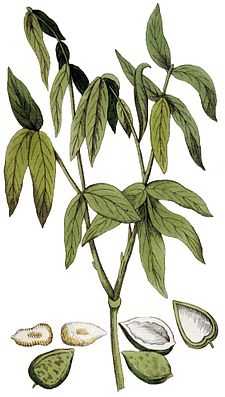Sapindus saponaria
| Sapindus saponaria | |
|---|---|
 | |
| Sapindus saponaria, early 19th century botanical illustration | |
| Scientific classification | |
| Kingdom: | Plantae |
| (unranked): | Angiosperms |
| (unranked): | Eudicots |
| (unranked): | Rosids |
| Order: | Sapindales |
| Family: | Sapindaceae |
| Genus: | Sapindus |
| Species: | S. saponaria |
| Binomial name | |
| Sapindus saponaria L.[1] | |
| Subspecies | |
|
S. s. var. drummondii | |

Sapindus saponaria is a small to medium-sized deciduous tree[2] native to the Americas. Common names include wingleaf soapberry, western soapberry, jaboncillo,[1] and mānele (Hawaiian).[3] Its genus name, "Sapindus", comes from the Latin, meaning Indian soap, and its specific epithet means "soapy."[2]
Description
It often grows in clumps or thickets reaching about 20 ft. (6.1 m) in height in the western part of its range. Solitary trees though can grow as tall as 50 ft. (15.2 m) in height. In the western part of its range it is most often found growing at the head of prairie ravines, the margins of woodlands, the edges of fields or on rocky hillsides.
The leaves of the soapberry are alternate, pinnately compound, thick and leathery but deciduous, 8 in. (20 cm) to 15 in. (38 cm) in length, made up of 6 to 20 narrow lanceolate leaflets with smooth margins, long tapered tips, and uneven wedge-shaped bases which are 2 in. to 5 in. (5 cm to 13 cm) long and .75 in. to 1.5 in. (2 cm to cm) wide. Midveins on leaves of var. saponaria are mostly winged, while those of var. drummondii are never winged.
The inflorescence are dense terminal panicles of small white flowers 6 in. to 10 in (15 cm to 20 cm) long. Flowering occurs in May-June for var. drummondii and in November for var. saponaria.
The fruit occur in large pyramidal clusters at the ends of branches. Each golden colored fruit is between 1.2 in. to 1.4 in. (3 cm to 3.6 cm) in diameter and becomes translucent and wrinkled when fully mature and contains a single black seed about .35 in (9 mm) in diameter. Fruits of var. drummondii ripen in October and often remain on the tree until spring, while those of var. saponaria ripen in spring.
The twigs of var. drummondii are gray-brown and hairy with short tan colored hairs while those of var. saponaria are gray and hairless. Buds on var. drummondii are small dark brown and hairy while those on var. saponaria are small brown and hairless.
The trunk of var. drummondii has light gray, scaly with thin plate like bark and sometimes shallowly furrowed while var. saponaria has gray to reddish colored scaly bark.
Subspecies
- S. s. var. drummondii (Hook. & Arn.) L.D.Benson (syn. S. drummondii Hook. & Arn.) – Western Soapberry[4] native from Arizona across to Louisiana in the south ranging north to Kansas and far southwestern Missouri in the north. It is also native to the states of Sonora, Chihuahua, and Coahuila in Mexico.[2]
- S. s. var. saponaria (syn. S. marginatus Willd., S. thurstonii Rock) – Wingleaf Soapberry[5] native almost exclusively to far south Florida in the United States but also occurs in an isolated area of coastal southeast Georgia. It is also found in the Caribbean, Central and South America,[1] and island of Hawaiʻi).[3]
Notable specimens
- The US national champion Sapindus saponaria var. drummondii is located in southern Johnson County, Kansas and measures 59 ft. (18 m) tall, 39 ft. (11.9 m) wide with a trunk diameter at 4 1/2 ft. (1.4 m) of 10 1/2 ft. (3.2 m) in circumference.[6]
- The US national champion Sapindus saponaria var. saponaria is located in Hawaii County, Hawaii and measures 73 ft. (22.25 m) tall, 57 ft. (1.74 m) wide with a trunk diameter at 4 1/2 ft. (1.4 m) of 2 1/2 ft. (76 cm) in circumference.[7]
See also
References
- ↑ 1.0 1.1 1.2 "Taxon: Sapindus saponaria L.". Germplasm Resources Information Network. United States Department of Agriculture. 1994-08-23. Retrieved 2010-11-02.
- ↑ 2.0 2.1 2.2 Matt Turner (2009). Remarkable Plants of Texas: Uncommon Accounts of Our Common Natives (Corrie Herring Hooks Series). Austin: University of Texas Press. pp. 95–97. ISBN 0-292-71851-9.
- ↑ 3.0 3.1 "Sapindus saponaria". Hawaiian Native Plant Propagation Database. University of Hawaiʻi at Mānoa. Retrieved 2010-11-02.
- ↑ "Sapindus saponaria var. drummondii". Integrated Taxonomic Information System. Retrieved 2010-11-02.
- ↑ "Sapindus saponaria var. saponaria". Integrated Taxonomic Information System. Retrieved 2010-11-02.
- ↑ American Forests (2007). "Western Soapberry Record". Retrieved June 29, 2012.
- ↑ American Forests (2007). "Wingleaf Soapberry Record". Retrieved June 29, 2012.
External links
![]() Media related to Sapindus saponaria at Wikimedia Commons
Media related to Sapindus saponaria at Wikimedia Commons
![]() Data related to Sapindus saponaria at Wikispecies
Data related to Sapindus saponaria at Wikispecies